Opposed-piston engine
An opposed-piston engine is a piston engine in which each cylinder has a piston at both ends, and no cylinder head.
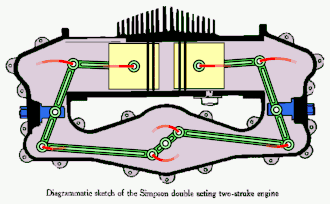
Petrol and diesel opposed-piston engines have been used, mostly in large scale applications such as ships, military tanks and in factories.
Design

1. Intake for fuel-air mixture
2. Supercharger
3. Airbox
4. Boost relief valve
5. Outlet crankshaft
6. Inlet crank mechanism
7. Cylinder with inlet and outlet slots
8. Exhaust
9. Water cooling jacket
10. Spark plug
Compared to contemporary two-stroke engines which used a conventional design of one piston per cylinder, the advantages of the opposed-piston engine were:
- Eliminating the cylinder head and valvetrain, which reduces weight, complexity, cost, heat loss and friction loss of the engine.[1][2][3]
- Creating a uniflow-scavenged movement of gas through the combustion chamber,[4][5] which avoided the drawbacks associated with the contemporary crossflow-scavenged designs (however later advancements have provided methods for achieving uniflow scavenging in conventional piston engine designs).
- A reduced height of the engine.
However the main drawback was that the power from the two opposing pistons has to be geared together. This added weight and complexity when compared to conventional piston engines, which simply use a single crankshaft as the power output.
The most common layout was to use two crankshafts, with the crankshafts geared together (in either the same direction or opposing directions).[6] The Koreyvo, Jumo and Napier Deltic engines used one piston per cylinder to expose an intake port, and the other to expose an exhaust port. Each piston is referred to as either an intake piston or an exhaust piston depending on its function in this regard. This layout gives superior scavenging, as gas flow through the cylinder is axial rather than radial, and simplifies design of the piston crowns. In the Jumo 205 and its variants, the upper crankshaft serves the exhaust pistons, and the lower crankshaft the intake pistons. In designs using multiple cylinder banks, each big end bearing serves one inlet and one exhaust piston, using a forked connecting rod for the exhaust piston.
History
1880s to 1930s
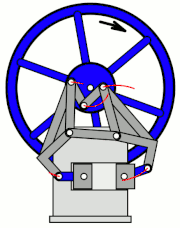
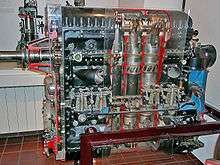
One of the first opposed-piston engines was the 1882 Atkinson differential engine.[7] The Atkinson differential engine has a power stroke on every rotation of the crankshaft (compared with every second rotation for the contemporary Otto cycle engine), however it was not a commercial success.[8]
In 1898, an Oechelhäuser two-stroke opposed-piston engine producing 600 hp (447 kW) was installed at the Hoerde ironworks.[9] This design of engine was also produced under licence by manufacturers including Deutsche Kraftgas Gesellschaft in Germany and William Beardmore & Sons Ltd in the United Kingdom.[10]
In 1901, the Kansas City Lightning Balanced Gas and Gasoline Engines were gasoline engines producing 4–25 hp (3–19 kW).[11]
An early opposed-piston car engine was produced by the French company Gobron-Brillié around 1900. In April 1904 a Gobron-Brillié car powered by the opposed-piston engine was the first car ever to exceed 150km/h with a "World's Record Speed" of 152.5 km/h (95 mph).[12] On 17 July 1904, the Gobron-Brillié car became the first to exceed 100 mph (161 km/h) for the flying kilometre.[13] The engine used a single crankshaft at one end of the cylinders and a crosshead for the opposing piston.
The first diesel engine with opposed pistons was a prototype built at Kolomna Works in Russia. The designer, Raymond A. Koreyvo, patented the engine in France on 6 November 1907 and displayed the engine at international exhibitions, however it did not reach production. The Kolomna design used a typical layout of two crankshafts connected by gearing.
In 1914, the Simpson's Balanced 2-Stroke motorcycle engine was the first opposed-piston engine to use a single crankshaft beneath the centre of the cylinders with both pistons connected by levers.[14] This engine was a crankcase compression design, with one piston used to uncover the transfer port, and the other to open the exhaust port. The advantage of this design was to avoid the deflector crowns for pistons used by most two-stroke engines at that time.
Doxford Engine Works in the United Kingdom built large opposed-piston engines for marine use, with the first Doxford engine being installed in a ship in 1921.[15] This diesel engine used a single crankshaft at one end of the cylinders and a crosshead for the opposing piston.[16][17] After World War I, these engines were produced in a number of models, such as the P and J series, with outputs as high as 20,000 hp (14,914 kW). Production of Doxford engines in the UK ceased in 1980.[16][18][19]
Later opposed-piston diesel engines include the 1932 Junkers Jumo 205 aircraft engine built in Germany, which had one crankshaft, using a design similar to the 1900–1922 Gobron-Brillié engines.[20]
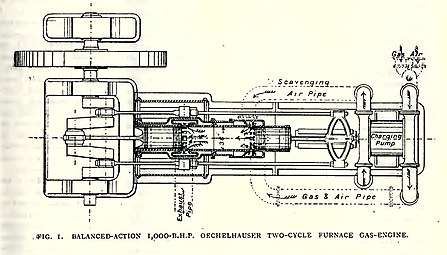 1898 Oechelhäuser Gas Engine
1898 Oechelhäuser Gas Engine.jpg) 1900 Gobron-Brillié opposed-piston engine with overhung yoke
1900 Gobron-Brillié opposed-piston engine with overhung yoke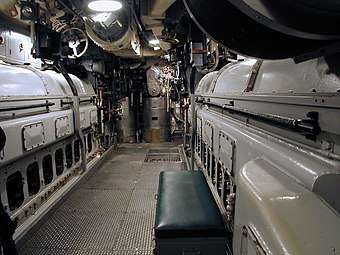 Fairbanks Morse 38 8-1/8 diesel engine on the USS Pampanito submarine
Fairbanks Morse 38 8-1/8 diesel engine on the USS Pampanito submarine
1940s to present
The Fairbanks Morse 38 8-1/8 diesel engine, originally designed in Germany in the 1930s, was used in U.S. submarines in the 1940s and 1950s, and in boats from the 1930s-present.[21] It was also used in locomotives from 1944.
The Commer TS3 three-cylinder diesel truck engines, released in 1954, have a single crankshaft beneath the centre of the cylinders with both pistons connected by levers.[22]
Also released in 1954 was the Napier Deltic engine military boats. It uses three crankshafts, one at each corner, to form the three banks of double-ended cylinders arranged in an equilateral triangle. The Deltic engine was later British Rail Class 55 and British Rail Class 23 locomotives and to power fast patrol boats and Royal navy mine sweepers. Beginning in 1962, Gibbs invited Mack Trucks to take part in designing FDNY’s super pumper and its companion tender. DeLaval Turbine was commissioned to design a multi-stage centrifugal pump with a Naper-Deltic T18-37C diesel to power the pumps. https://www.firerescue1.com/fire-products/fire-apparatus/articles/the-greatest-fire-pumper-the-world-has-known-TrMsI86bXHcXv1iq/
In 1959, the Leyland L60 19 L (1,159 cu in) six-cylinder diesel engine was introduced. The L60 was produced in the United Kingdom for use in the Chieftan tank. The Soviet T-64 tank, produced from 1963-1987, also used an opposed-piston diesel engine.
Free-piston engine
A variation of the opposed-piston design is the free-piston engine, which was first patented in 1934. Free piston engines have no crankshaft, and the pistons are returned after each firing stroke by compression and expansion of air in a separate cylinder. Early applications were for use as an air compressor or as a gas generator for a gas turbine.
See also
References
- Pirault, Jean-Pierre; Flint, Martin (2010). Opposed Piston Engines: Evolution, Use, and Future Applications. SAE International. ISBN 9780768018004. Retrieved 20 November 2019.
- Foster, D.; Herold, R.; Lemke, J.; Regner, G.; Wahl, M. (2011). "Thermodynamic Benefits of Opposed-Piston Two-Stroke Engines". SAE Technical Paper Series. 1. PA: SAE International. doi:10.4271/2011-01-2216.
- "Start-Ups Work to Reinvent the Internal Combustion Engine". www.nytimes.com. 30 March 2011. Retrieved 29 November 2019.
- "Opposed-Piston". www.achatespower.com. Retrieved 29 November 2019.
- "TROPE : Toroidal Opposed Piston Engine". www.youtube.com. frankydevaere. Retrieved 29 November 2019.
- "OPRE: Opposed piston Pulling Rod Engine". www.pattakon.com. Retrieved 29 November 2019.
- Gingery, Vincent (2000). Building the Atkinson Differential Engine. David J. Gingery Publishing, LLC. ISBN 1878087231.
- "Atkinson Differential Engine Replica - Gas Engines". www.gasenginemagazine.com. Retrieved 22 November 2019.
- "Large Gas Engines on the Continent". Page's Weekly (23 June 1905): 1336–1337.
- Stokes, Jason W. B.; Cunningham, Jason (1909). "The Oechelhauser Gas Engine in Great Britain: Paper Read Before the Glasgow University Engineering Society, November 11th, 1909". William Beardmore & Company Limited. Cite journal requires
|journal=(help) - "Struck by Lightning: The Kansas City Hay Press Co. - Gas Engines". www.farmcollector.com. Retrieved 26 November 2019.
- "The Automotor Journal" (9 April 1904): 421. Cite journal requires
|journal=(help) - "Gobron-Brillie history". www.uniquecarsandparts.com.au. Archived from the original on 25 August 2013.
- "A Horizontally Opposed Two-stroke Engine". The Motor Cycle (6 August 1914): 204.
- "Index Doxford site". www.telenet.be. Retrieved 26 November 2019.
- "Marine Engines – Doxford". www.OldEngine.org. Archived from the original on 2 December 2013.
- "PatOP: Single-Crankshaft Opposed-Piston Engine". www.pattakon.com. Retrieved 29 November 2019.
- "Doxford Engines 1878–1980". www.doxford-engine.com. Archived from the original on 24 December 2016. Retrieved 28 March 2006.
- "Junkers Ship Engines". www.geocities.com. Archived from the original on 25 October 2009.
- Setright, L. J. K. (1975). Some unusual engines. Mechanical Engineering Publications for the Institution of Mechanical Engineers. ISBN 9780852982082. Retrieved 20 November 2019.
- "Fairbanks-Morse 38D8 Diesel Engine". www.psrm.org. Archived from the original on 26 May 2006.
- "Rootes-Lister – TS3 Horizontally Opposed Piston Engine". www.OldEngine.org. Archived from the original on 25 February 2008.
- "Two-stroke Opposed Piston Internal Combustion Engine". www.espacenet.com. Retrieved 20 November 2019.